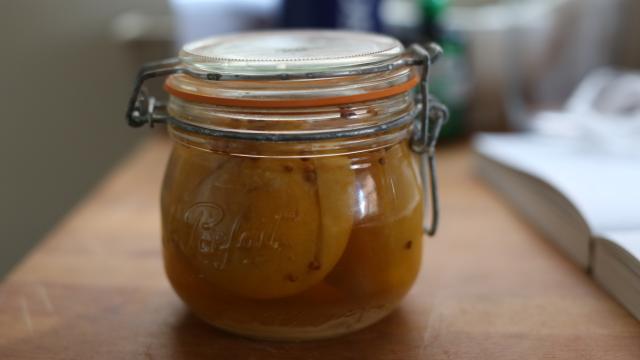I like to divide my life into two eras: The time before I knew about preserved lemons and the time after I knew about preserved lemons. Unlike fresh lemon zest or juice, these funky little wedges add a bit of umami along with acidic brightness.
Photo by Squirrel Nation.
Basically, they’re good on everything — savoury and sweet — and, though you can buy them at most specialty grocery stores, they’re a cinch to make. In their simplest form, all you need to make preserved lemons are the lemons themselves and some salt. (You can also add sugar, peppercorns, bay leaves, or any other spice you fancy, but I like to keep it simple.)
[referenced url=”https://www.lifehacker.com.au/2016/11/two-ingredient-preserved-limes-are-easy-and-add-bright-citrus-flavour-to-anything/” thumb=”https://i.kinja-img.com/gawker-media/image/upload/t_ku-large/vtxyutdoaqi2g9tfrxxl.jpg” title=”Two-Ingredient Preserved Limes Are Easy And Add Bright, Citrus Flavour To Anything” excerpt=”A squeeze of lime brightens up beverages, fish, tacos, fish tacos and all sorts of other things, but preserving them takes their flavorful impact to great new heights.”]
Just wash a few lemons well (regular or Meyer both work) and trim a little bit off of each end. Then cut the lemon lengthwise into four sections, keeping the quarters connected at one end. Put the fruit in a bowl and toss with plenty of salt (about 1/2 of a cup for eight lemons) making sure it gets down in between the quarters. Cover with plastic wrap and place the bowl in the fridge overnight, so the lemons can release their delicious juices into the world.
The next day, transfer the salty lemons and their juice to a sterilised canning jar, tamping them down to really cram ’em in there. Once you have a jar full of lemon wedges submerged in their own liquid (you can squeeze more lemon juice on top if needed), seal your jar (or jars) and put them in a cool, dry place for at least a couple of weeks, shaking daily to help tenderise the rinds. Transfer the whole situation to the fridge, where it will keep for up to a year.
Once you’ve endured the exquisite agony of waiting for these things to ferment, you are finally ready to enjoy your reward. Remove a wonderful wedge (or seven) from the jar and rinse off any excess salt. The pulp can be scraped into simmering soups and stews, whisked into salad dressings, or mixed with plain store-bought mayo for a spread that’s so good you’ll seriously consider spreading all over your body. The chopped rind can be sprinkled over grilled meats, pasta dishes, salads, or anything that needs a pop of bright, tart and savoury flavour. You can also just throw whole wedges into dishes and let the eater choose their own adventure.
With the exception of like, lemonade, almost any recipe that calls for regular, boring lemons is instantly upgraded with lemons of the preserved variety. Heck, this even extends into cocktails. Preserved lemon rind makes an excellent martini garnish, and the pickling liquid really jazzes up a Bloody Mary. Once you start using preserved lemons, you will find yourself low-key obsessed with finding new ways to use them, which will not be hard. My current obsession mixing the chopped rinds into every dip and spread I make, and it’s going very well. I’m also really excited about trying my hand at a preserved lemon tart.

Comments